In a 2022 trial involving 30 companies and over 1,000 employees across the United States, Ireland, and Australia, a bold experiment unfolded. The challenge: adopt a four-day, 32-hour work week for six months. The unique twist? Employees worked 80% of their regular hours but received 100% of their pay and committed to maintaining 100% of their standard output.
This trial, orchestrated by the nonprofit 4 Day Week Global and Boston College professors, sparked a new conversation on work week structures. In this blog, we discuss everything you need to know about mastering the 4 day work week. Read along!

Rethinking Work Schedules: The Rise of the 4 Day Work Week
Today, the traditional work schedules are undergoing a profound transformation. The 9-to-5 paradigm is no longer the exclusive norm as forward-thinking companies explore alternative approaches. At the forefront of this shift is the rising popularity of the 4 day work week.
What is a 4 day work week?
A 4 day work week is a compressed work schedule where employees complete their standard full-time hours in four days instead of the traditional five. This does not mean that the work time is decreased; instead, in this arrangement, the typical workday is extended to accommodate the same total number of working hours per week, often resulting in four days of concentrated effort followed by a three-day weekend. A number of countries, including Iceland, Canada, Spain, and the UK, have a majority of the workforce working 4-day work weeks.

Factors Driving Adoption of the 4 day work week
The adoption of the 4 day work week is driven by several key factors, reflecting the changing dynamics of the modern workplace and the evolving expectations of both employers and employees. Here are some prominent factors fueling the shift towards a condensed work week:
Employee Wellbeing and Work-Life Balance:
A primary motivator for embracing the 4 day work week is the desire to enhance employee well-being. The condensed schedule allows for an extra day off, providing employees with more time to rest, rejuvenate, and attend to personal or family matters. This focus on work-life balance is increasingly recognized as crucial for maintaining a healthy and engaged workforce.
Increased Productivity and Focus:
Contrary to traditional beliefs, the 4 day work week challenges the notion that longer hours equate to higher productivity. By compressing work into a shorter working week, employees often report heightened focus and efficiency. This model encourages a results-oriented approach, emphasizing the quality of work over the quantity of hours spent at the workplace.
Talent Attraction and Retention:
Offering a 4 day work week has become a competitive advantage in attracting and retaining top talent. Job seekers and employees, particularly in competitive industries, increasingly prioritize flexible work arrangements. Companies that embrace the 4 day work week position themselves as employers of choice, appealing to a diverse and skilled workforce.
Adaptation to Remote Work Trends:
The future of work is here, and the rise of remote work has accelerated the acceptance of alternative work schedules. With technology enabling seamless connectivity, organizations recognize that employees can maintain productivity while enjoying the flexibility of a compressed work week. The 4 day model aligns well with the growing trend of remote and hybrid work arrangements.

Focus on Results and Output:
Shifting from a time-centric approach to a results-oriented mindset is a key driver. The 4 day work week encourages organizations to prioritize outcomes rather than mere presence. By setting clear goals and expectations, companies can evaluate performance based on deliverables and achievements, fostering a culture of accountability.

Environmental and Sustainability Considerations:
Some organizations adopt the 4 day workweek as part of broader sustainability initiatives. Reduced commuting and office energy consumption contribute to a smaller carbon footprint. This aligns with the increasing awareness of corporate social responsibility and environmentally conscious business practices.
Employee Morale and Engagement:
Shorter work weeks can positively impact employee morale and engagement. Employees appreciate the additional leisure time, which can contribute to higher job satisfaction and a more positive company culture. This, in turn, may lead to increased loyalty and a sense of commitment among the workforce.
Challenges of a 4 Day Work Week
While the idea of a 4-day work week has gained traction as a potential solution to improve work-life balance and increase employee satisfaction, there are concerns and drawbacks associated with this arrangement. It’s important to note that the impact of a 4-day work week can vary depending on the nature of the job, industry, and individual preferences. Here are some reasons why a 4-day work week may be considered challenging or unfavorable:
Extended Daily Work Hours:
To compensate for the reduction in the number of workdays, employees might be required to extend their daily work hours. Longer workdays can lead to fatigue, burnout, and decreased productivity, counteracting the intended benefits.
Incompatibility with Certain Jobs:
Some professions and industries may find it challenging to adopt a 4-day work week due to the nature of their work, client demands, or the need for continuous services. Jobs that require round-the-clock availability or adherence to specific schedules may not be suitable for a compressed workweek.
Potential for Increased Stress:
The transition to a 4-day work week could increase stress levels for some employees, particularly if they struggle to manage heavier workloads within the condensed timeframe. This could potentially offset the intended improvement in work-life balance.
Customer Service and Client Expectations:
Businesses that rely on regular client interactions or customer service may find it difficult to meet expectations within a compressed workweek. Reduced availability may impact client satisfaction and relationships.
Adaptation Period and Implementation Challenges:
Implementing a 4-day work week requires careful planning and may pose challenges during the initial adaptation period. Changes in workflow, communication, and productivity may take time to stabilize.
We recommend careful consideration and thorough assessment of the unique needs and dynamics of your organization before implementing a 4-day work week.
Now that we’ve seen what factors drove the adoption of the 4 day work week, let’s look at how you can implement it at your work.
Strategies for Implementing a 4 Day Work Week Schedule
If you’re contemplating the transition to a 4 day work week, it is imperative to have a comprehensive strategy in place.
Crafting a Robust Transition Plan
Assess Organizational Readiness:
Conduct a thorough assessment of the organization’s current structure, employee workload, and operational requirements to gauge readiness for the 4 day work week transition.
Communicate Transparently:
Establish clear communication channels to inform employees about the impending changes. Clearly articulate the reasons behind the transition, expected benefits, and how the organization plans to support a successful shift.
Involve Employees in the Planning Process:
Solicit feedback and involve employees in the planning process. Understanding their preferences, concerns, and suggestions is crucial for designing a schedule that resonates with the workforce.
Gartner recommends a phased approach for implementing a 4 day work week. The “crawl” stage involves a pilot, like a seasonal 4 day work week in one department. The “walk” stage expands the pilot for continuous improvements across the organization, while the “run” stage represents the final desired state—a year-round 4 day work week.
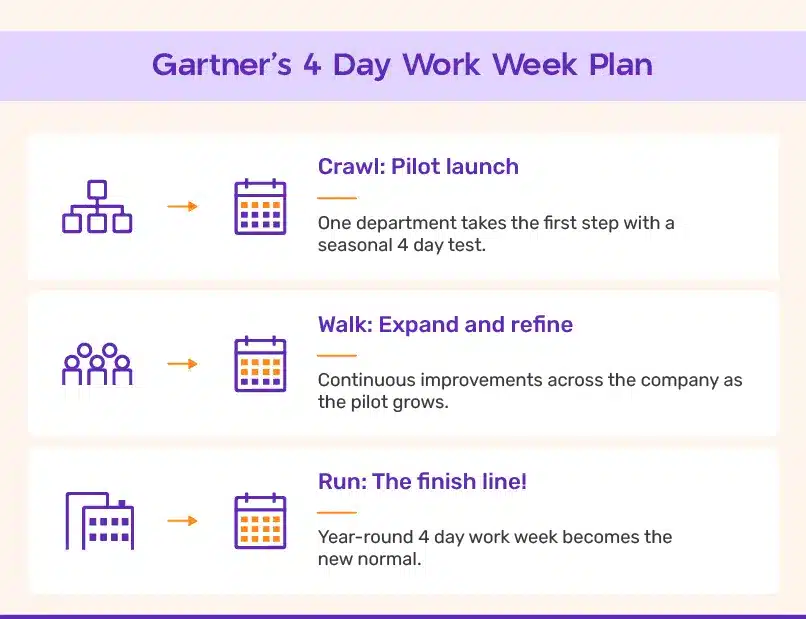
Designing an Effective 4 Day Work Week Schedule
Designing an effective schedule goes beyond merely compressing hours; it involves aligning business objectives, accommodating employee preferences, and integrating performance management frameworks.
Aligning with Business Objectives
Identify Core Business Goals:
Before initiating any schedule changes, it’s crucial to identify and understand the core business objectives. Determine key performance indicators (KPIs) and ensure that the new 4 day work week schedule aligns with these goals.
Peoplebox facilitates alignment between business and individual goals by providing a comprehensive platform for setting, tracking, and managing OKRs. This ensures that employees’ objectives are directly linked to the organization’s strategic priorities, fostering a culture of accountability and driving cohesive goal alignment across the entire workforce.
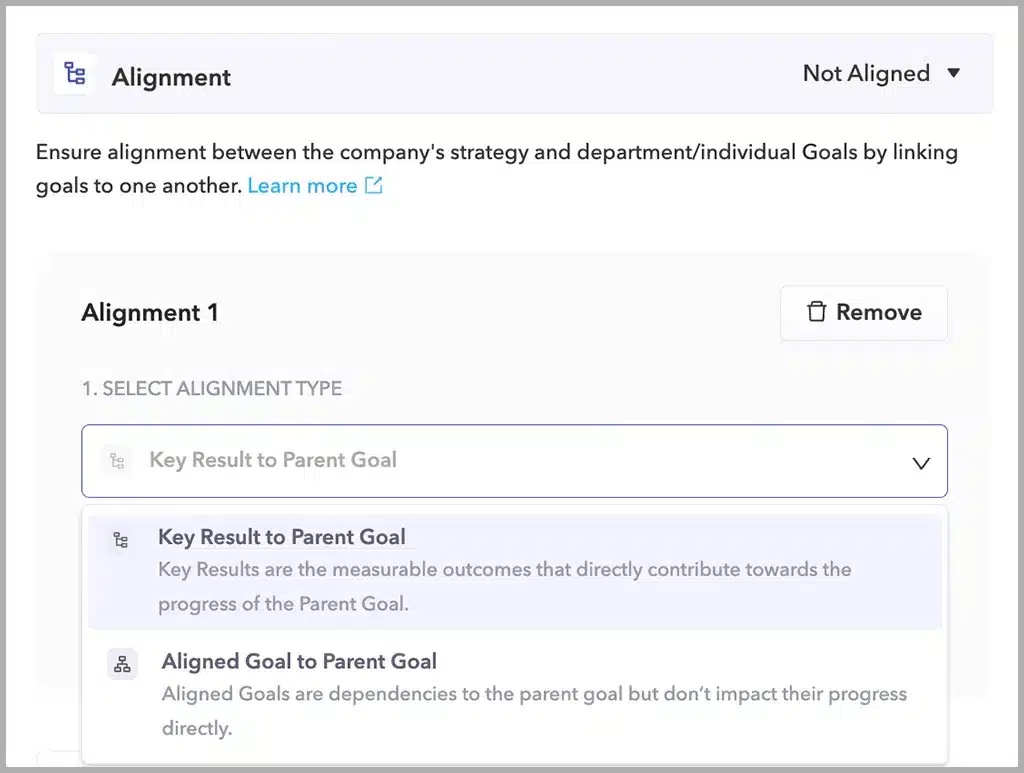
Critical Task Distribution:
Evaluate the nature of critical tasks within your organization. Ensure that essential functions, deadlines, and client commitments are strategically distributed across the 4 day work week, minimizing potential disruptions.
Employee Availability and Workflow:
Analyze peak periods of employee availability and workflow. Align the schedule to accommodate periods of high productivity, ensuring that the condensed work week enhances efficiency rather than hindering it.
ProTip: Choose a 4 day work week model that aligns with your organization’s goals and industry requirements. Common models include:
- 4 days x 10 hours: Employees work 4 longer days each week.
- Compressed work week: Employees work the same total hours but in fewer days.
- Flexible scheduling: Allowing employees to choose their work hours within set parameters.
Employee Preferences and Work Styles
Conduct Employee Surveys:
Gather insights into employee preferences through surveys or focus group discussions. Understand preferred work hours, potential challenges, and the types of flexibility employees value the most.

Flexible Start and End Times:
Recognize the diverse needs of your workforce by incorporating flexible start and end times. This not only accommodates varying commute times but also allows employees to align their work hours with their natural productivity peaks.
Trial Period and Feedback Loops:
Consider implementing a trial period before fully implementing the 4 day work week schedule. Solicit continuous feedback from employees and use this information to fine-tune the schedule, ensuring it resonates with the workforce.
Leveraging Performance Management Tools To Make 4 Days a Week Work Effective
Embracing a 4 day work week can be transformative for both employees and organizations, but its success hinges on effective performance management.
Leveraging new technologies like performance management tools plays a crucial role in ensuring that the transition to a condensed work schedule is not only seamless but also enhances overall productivity. Here’s how these tools contribute to making a 4 day work week effective:
Continuous Feedback and Goal Tracking:
Performance management tools provide a structured framework for continuous feedback. Regular check-ins and goal-tracking mechanisms enable ongoing communication between managers and employees, ensuring that individual and team efforts align with organizational objectives.
Peoplebox enables you to schedule regular 1-on-1s with your employees effortlessly. Moreover, if you’re uncertain about which questions to pose, Peoplebox provides suggested talking points to facilitate impactful check-ins.
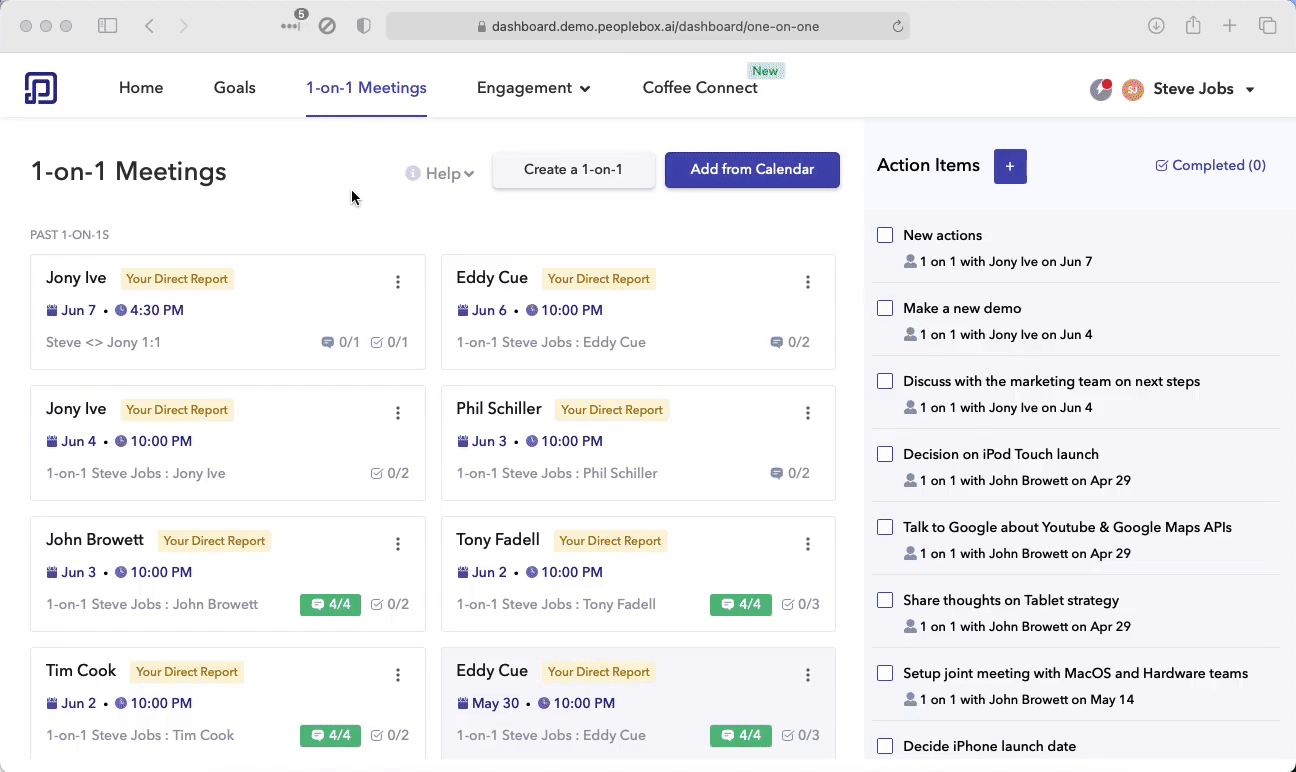

Schedule Review Meetings On The Go With Peoplebox
Real-Time Performance Insights:
These tools offer real-time visibility into employee performance. By monitoring achievements and outputs, managers can make informed decisions, recognizing accomplishments promptly and addressing challenges proactively, even within the compressed timeframe of a 4 day work week.
Peoplebox provides analytics and reporting features that allow businesses to assess performance, identify trends, and make data-driven decisions.
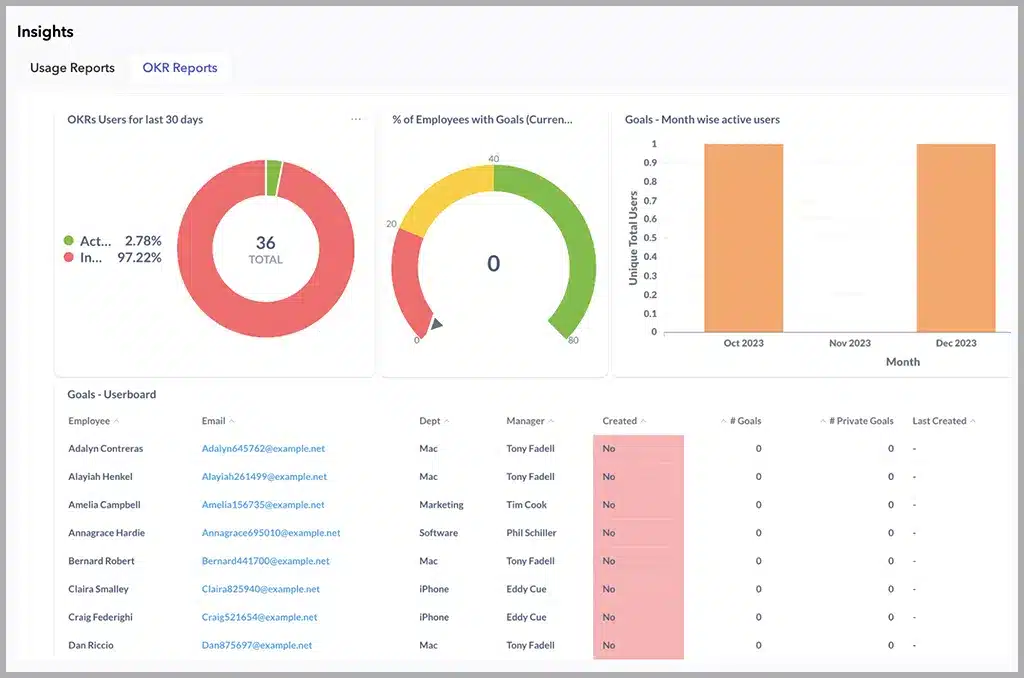
Adaptability and Agile Goal Setting:
A 4 day work week demands adaptability. Performance management tools support agile goal-setting processes, enabling organizations to swiftly adjust objectives based on evolving priorities. This flexibility ensures that the compressed schedule aligns with dynamic business needs.

Remember, implementing any new framework at work comes with its own set of challenges. Let’s dive into some of the common challenges of implementing a 4 day work week schedule.
Addressing Common Challenges and Concerns of 4 Day Work Week
Transitioning to a 4 day work week presents organizations with a unique set of challenges and concerns that require thoughtful consideration and strategic solutions.
Challenge 1: Productivity and Workload Management
Solution: Implementing Agile Work Practices
To maintain productivity and effective workload management, organizations can adopt agile work practices. This includes setting clear priorities, establishing realistic goals, and encouraging open communication among team members. Employers can also consider leveraging project management tools and techniques to streamline workflows and ensure efficient task allocation. Additionally, providing training on time management and prioritization can empower employees to make the most of their shortened work week.
Challenge 2: Client and Customer Expectations
Solution: Proactive Communication and Service Adjustments
To mitigate potential disruptions in client and customer interactions, proactive communication is key. Businesses can inform their clients about the transition to a 4 day work week well in advance, setting clear expectations regarding service hours and response times. Adjusting customer service schedules, if necessary, and ensuring seamless communication channels, such as chat support or automated responses, can help maintain strong client relationships during the transition.
Challenge 3: Employee Well-being and Burnout
Solution: Emphasize Work-Life Balance and Mental Health Support
To address concerns about employee well-being and burnout, organizations should prioritize work-life balance and mental health support. This can be achieved through initiatives such as flexible work hours, remote work options, and regular wellness programs. Providing access to mental health resources, offering stress management workshops, and encouraging open dialogue about work-related stress can help mitigate the risk of burnout and support employees’ overall well-being.
With Peoplebox, you can set up automated engagement surveys to periodically check in on your employees to make sure they are alright.
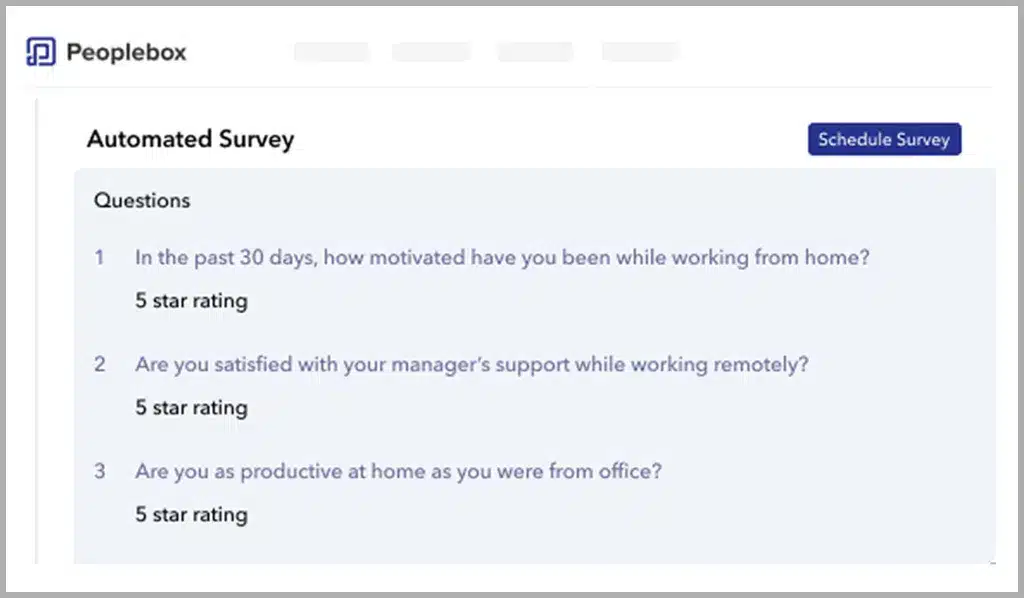

Challenge 4: Impact on Salary and Benefits
Solution: Transparent Communication and Flexible Benefit Plans
Transparent communication regarding any potential changes to compensation and benefits is crucial. Employers can explore options such as flexible benefit plans, where employees can customize their benefits to suit their individual needs. Pro-rated salary adjustments can also be considered to ensure that employees are fairly compensated for their work while transitioning to a 4 day work week.
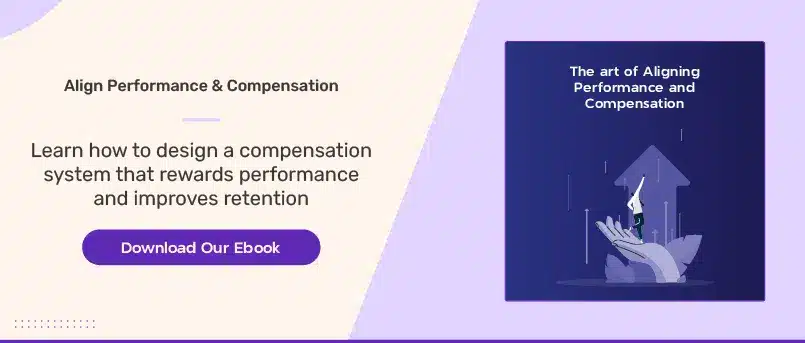
Challenge 5: Performance Management in a 4 day Work Week
Solution: Outcome-Based Performance Metrics and Regular Feedback
To effectively manage performance in a 4 day work week, organizations can shift their focus towards outcome-based performance metrics. Emphasis can be placed on the quality of work produced and the achievement of key objectives. Regular feedback and performance evaluations play a crucial role in ensuring that employees are aligned with organizational expectations.
Managers can schedule frequent check-ins to provide guidance, support, and recognition for accomplishments. Additionally, the use of performance management tools and software can aid in tracking progress, setting goals, and providing a transparent overview of individual and team performance.
With Peoplebox, you can gain a comprehensive overview of both the organization’s performance and each individual’s performance.
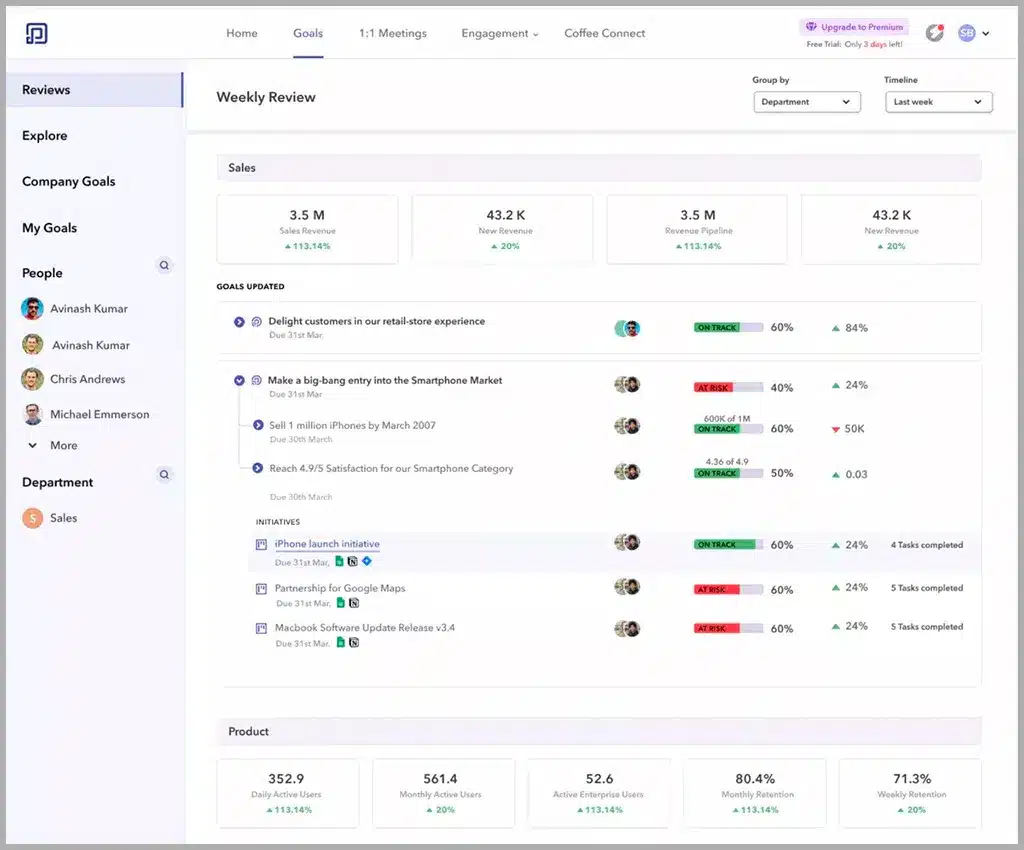

By addressing these challenges with comprehensive solutions and emphasizing effective performance management, organizations can successfully navigate the transition to a 4 day work week while maintaining productivity, employee satisfaction, and overall success.
Real-life Examples of 4 Day Work Week Schedules
Several companies have embraced the 4 day work week with remarkable success, demonstrating that a shorter work week can lead to increased productivity, improved employee satisfaction, and positive business outcomes. Let’s explore some real-world examples of organizations that have effectively implemented a 4 day work week:
Bolt Financial’s Transformation:
In 2021, Bolt Financial embarked on a three-month trial of the four-day work week, and the positive results prompted a permanent shift starting January 1st, 2022. The company maintains flexibility in work hours but designates the four days as collaborative workdays to ensure minimal disruptions from meetings, allowing employees to savor a well-deserved Friday.
Buffer’s Employee Satisfaction:
Buffer, known for its progressive approach, tested the four-day work week in May 2020. A survey revealed a remarkable 91% increase in employee happiness and productivity. Encouraged by these outcomes, Buffer fully implemented the policy, establishing itself as a pioneer in the social media management industry.
Lamborghini’s European Automotive Shift:
In December 2023, luxury carmaker Lamborghini broke new ground in the European automotive industry by announcing a four-day work week for its production workers without a reduction in pay. This move reflects a departure from the industry norm and signals a growing trend in prioritizing employee well-being.
Microsoft Japan’s Productivity Boost:
Microsoft Japan‘s 2019 trial of the four day work week resulted in an astounding 40% increase in productivity, leading to a permanent adoption of the policy. While the U.S. offices may not have followed suit yet, the success in Japan suggests a potential shift in the broader business landscape.
Unilever New Zealand’s Flexibility Initiative:
Unilever New Zealand embraced the 4 day work week, allowing employees to work four days while receiving pay for five. This initiative aimed to enhance flexibility and promote a healthy work-life balance. Positive feedback from employees highlighted increased engagement and motivation, showcasing the benefits of this alternative work structure.
Perpetual Guardian’s Productivity Surge:
A New Zealand company, Perpetual Guardian made headlines by permanently adopting the 4 day work week after a successful trial. The company reported a remarkable 20% increase in productivity and improvements in work-life balance, leading to reduced stress levels and higher job satisfaction among employees. This success story garnered international attention, sparking discussions about the viability of alternative work arrangements.
Boost Productivity in 4 Day Work Week with Peoplebox
Productivity in a 4 day work week is not a far-fetched dream if you have the right tools by your side. Peoplebox emerges as a valuable ally, offering innovative solutions to streamline goal-setting, communication, collaboration, and performance management.
Peoplebox provides a comprehensive platform for setting, tracking, and reviewing OKRs, aligning teams with organizational goals, and fostering a culture of accountability.
It also offers a range of tools to facilitate continuous feedback, goal setting, and performance reviews, empowering managers and employees to stay aligned and focused on key objectives. By leveraging Peoplebox’s performance management platform, organizations can ensure that employees remain motivated, engaged, and accountable, even in a compressed work schedule.
Ready to maximize productivity in a 4 day work week? Talk to our experts today for all your performance management needs.







